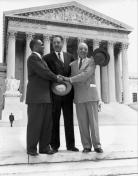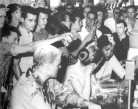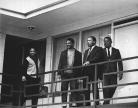Test Chronology: 01 The Master Narrative
Created by Jon Coburn on Wed, 06/05/2024 - 16:43
Part of Group:
Master Narrative chronology of the civil rights movement
Timeline
Chronological table
| Date | Event | Created by | Associated Places | |
|---|---|---|---|---|
| 17 May 1954 |
Brown v. Board of Education Strikes Down Segregation in Schools, May 17, 1954#HST3107 On May 17, 1954, the Supreme Court of the United States of America, led by chief justice Earl Warren, decided that the doctrine of "separate but equal" was inherently unconstitutional. The decision struck down segregation of American schools and set the stage for desegregation of public facilities throughout the United States. This decision is marked as the beginning of the civil rights-era in "master narrative" readings of the movement's history. |
Jon Coburn | ||
| 5 Dec 1955 to 20 Dec 1956 |
Montgomery Bus Boycott, 1955-1956#HST3107 The protest that brought Rosa Parks and Martin Luther King, Jr to public attention, the Montgomery Bus Boycott's successful demonstration of nonviolent resistance to segregation continues to be celebrated as the pinnacle of civil rights movement activism. |
Jon Coburn | ||
| 1 Feb 1960 to 25 Jul 1960 |
Greensboro Lunch Counter Sit-Ins#HST3107 On February 1, 1960, four Black students from North Carolina Agricultural and Technical State University sat at the segregated "whites only" lunch counter of Woolworths in Greensboro, North Carolina, and demanded service. Refused by servers, they refused to leave, and the Greensboro Lunch Counter Sit-Ins began. After several months of nonviolent protest, the students experiencing escalating violence from White citizens, the lunch counters were segregated. In tandem with the Montgomery Bus Boycott, the sit-in movement demonstrated the power of nonviolent protest. |
Jon Coburn | ||
| 2 Jul 1964 |
The Civil Rights Act 1964#HST3107 Spearheaded by President Lyndon B. Johnson in the aftermath of his predecessor's assassination, the Civil Rights Act came into effect on July 2nd, 1964. |
Jon Coburn | ||
| 6 Aug 1965 |
The Voting Rights Act 1965#HST3107 After the civil rights act, the voting rights campaign of SNCC experienced violence and death in Mississippi. Nonviolent marchers were beaten to death in Selma, Alabama. Catalysed by these efforts, President Johnson signed the Voting Rights Act into law on August 6th, 1965. |
Jon Coburn | ||
| 4 Apr 1968 |
The Assassination of Martin Luther King Jr.Martin Luther King Jr was one of the pioneers of the Civil Rights Movement in the 1950s-60s. He had a very strong commitment to preaching nonviolence and nonviolent solutions to their problems, despite the constant violence that they faced on a daily basis. Despite instances of lynching, police brutality, mass arrests and public beatings, the civil rights movement remained primarily nonviolent. However, during his time as an outspoken protestor, he was assassinated. On April 4th, 1968 he was fatally shot on the second floor balcony of a hotel in Memphis, Tennessee while going to be apart of a march for striking sanitation workers. After his death, rioting broke out across the country, especially in inner city areas. The one responsible for his death, James Earl Ray, had managed to stay on the run for about two months before he was found and captured in England. After being arrested, he pled guilty to the shooting and was given a prison sentence of 99 years. However, even after pleading guilty, he claimed for the rest of his life that he had been framed and had not actually been the one to assassinate King. He claimed that he had been set up by a conspiracy. “Assassination of Martin Luther King, Jr..” Encyclopædia Britannica, Encyclopædia Britannica, inc., 28 Mar. 2024, www.britannica.com/event/assassination-of-Martin-Luther-King-Jr. Curtis J. Austin / February 2002. “On Violence and Nonviolence: The Civil Rights Movement in Mississippi.” On Violence and Nonviolence: The Civil Rights Movement in Mississippi - 2002-02, www.mshistorynow.mdah.ms.gov/issue/the-civil-rights-movement-in-mississi.... Accessed 1 Apr. 2024. The Vietnam war would have been an integral part to the artist’s identity, which is why I included it in the timeline. He served for multiple years during the beginning of the conflict, which would have colored his outlook on life at the time. I believe that it affected the subject matter of his work and made his work inherently political, even if unintended. The civil rights movement and the assassination of Martin Luther King Jr. were also very integral to the subject of the photograph. During this time in history, it would’ve been the peak of the civil rights movement, where African Americans and other people of color fought for rights and recognition as people. This was integral to the identity of people of color at the time, as it paved the road for rights and being treated as people. These events definitely affected American culture at the time, to allow more acceptance even if just a little bit. This was a time in which America was forced to face its history of systemic racism and injustice. It caused an upheaval in the typical American day-to-day, giving birth to a new generation of activism, in which equality was a primary goal. The anti-war movement was a very powerful force during this time as well, as it influenced all culture, especially art and music. This very art piece by Bruce Davidson was also heavily affected by the events during this time period. I believe that this art is a reflection of all culture, even if indirectly. |
Kai Deline |






